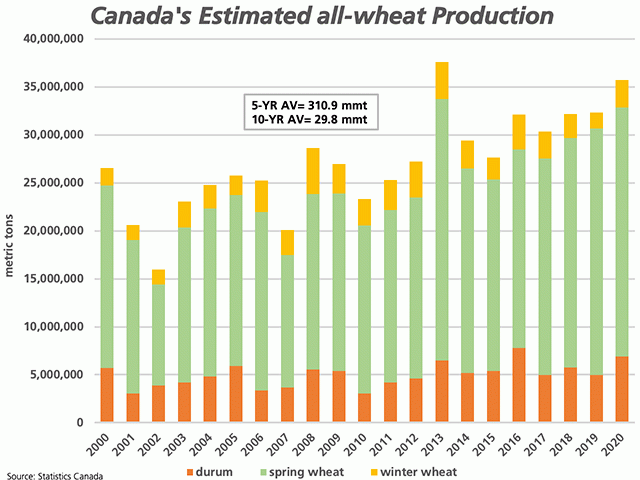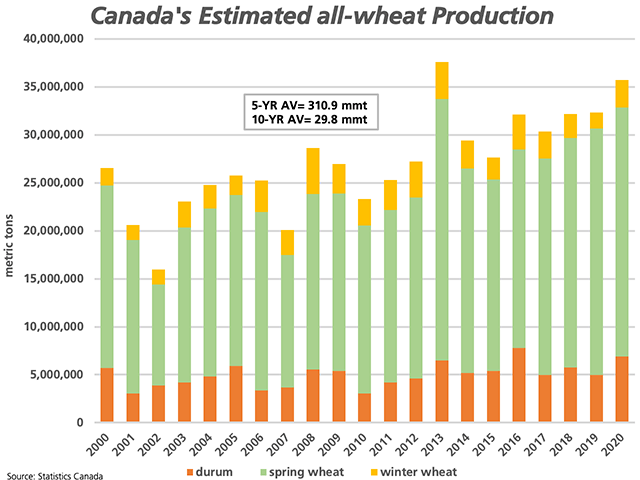Canada Markets
Statistics Canada Releases First Production Estimates
Aug. 31 saw the release of Statistics Canada's July estimates of production of principal field crops report, the first of two major reports slated for this week. The Stocks of principal field crops report to be released Sept. 4, looking at ending stocks for 2019-20 for all crops except for corn and soybeans.
Today's production report was a first for Statistics Canada, as it was switched to a model-based report, stating reasons linked to the global pandemic and the need to limit contact with producers.
This move may speed the implementation of Statistics Canada's AgZero project that has a goal of "using alternative data sources and advanced technologies, such as Earth Observation data and machine learning, to reduce the response burden on farmers to as close to zero as possible by 2026."
In 2020, the July estimates arrived at through a model-based methodology will be followed by the Model-based principal field crop estimates as of Aug. 31, due for release on Sept. 14.
Statistics Canada estimated Canada's all-wheat production at 35.740 million metric tons, which would be the second-largest crop ever next to the 37.6 mmt estimated for 2013. As seen on the attached chart, this volume would be 15.5% higher than the five-year average and 19.8% higher than the 10-year average.
The largest move was seen for the durum crop, with production up 1.949 mmt, or 39.2%, year-over-year to 6.926 mmt, above pre-report estimates averaging 6.14 mmt. This volume would be the second-largest crop ever produced, next to the 7.8 mmt produced in 2016 and 20.1% above the five-year average. This will weigh on markets due to a sharp increase in stocks year-over-year without a significant surge in exports. Durum yields are estimated higher than 2019, which includes a massive year-over-year increase in Alberta of 19.9 bushels per acre, or 62.2%, to 51.9 bpa, although yields in this province still trail the record achieved in 2016.
Canada's winter wheat production increased 69.3% year-over-year to 2.879 mmt, the largest realized in four years. This is largely due to a 57.8% increase in harvested acres forecast in Ontario to 1.035 million acres, accounting for 76.7% of the total, while this province's yield is estimated up 9.5% from 2019 to 84.1 bpa, the highest in three years.
P[L1] D[0x0] M[300x250] OOP[F] ADUNIT[] T[]
Canada's spring wheat production is estimated at 25.935 mmt, up 1% from 2019, the largest production in seven years and 14.9% higher than the five-year average. The estimate for spring wheat's harvested acres is down 4% from 2019, while current estimates point to a record average yield of 54.4 bpa, offsetting the lower acres. Average spring wheat yields include a record 61.8 bpa in Manitoba and a record 60.6 bpa in Alberta, while the estimated 46.9 bpa is below the 48.8 bpa record achieved in 2013.
The harvested acre estimates for Alberta bears watching in the upcoming report. Today's harvested acre estimate for the province represents 97.3% of seeded acres, despite the wet spring and summer conditions faced, up from 97% in 2019 and only slightly below the national average of 97.7%.
Today's canola production estimate was released at 19.403 mmt, down 0.4% from 2019, the lowest in five years and down 2.4% from the five-year average. It is important to note that this year-over-year comparison was only made possible by an 828,500 mt upward revision in 2019 production and a 251,400 mt increase in 2018 production, or close to 1.1 mmt overall. This production estimate was well-below the range of pre-report estimates that ranged from 19.880 mmt to 20.5 mmt, while producers continue to indicate the potential damage faced from August heat, that may have been missed in today's report. One southeast Saskatchewan producer tweeted today that August heat trimmed his canola crop's potential by 15 to 20% from previous expectations.
Canada's harvested acres of canola are forecast down 1.6% overall, which is due to a year-over-year drop in both Saskatchewan and Alberta. The national average yield is forecast to increase by 0.5 bpa from 2019, to 41.6 bpa, despite a year-over-year drop in both Manitoba and Saskatchewan. The average Alberta yield increased by 3.6 bpa, to 43.9 bpa, the highest in four years.
Today's canola data can be viewed as bullish for the crop, at a time when soybeans and soybean oil are trending higher and the USDA is already painting a bullish picture for global rapeseed/canola fundamentals. At the same time, Canadian dollar strength continues to limit upside potential. Focus will now be on the Sept. 4 stocks report to see how Statistics Canada deals with stocks, given the revisions in prior-year production.
Canada's barley production was estimated at 10.5 mmt, up 1.6% from last year and 20.5% above the five-year average. This is below the range of pre-report estimates from 10.960 mmt to 11 mmt.
Canada's oat production forecast at 4.5 mmt is the largest crop since 2007, up 6.2% from 2019 and 24.5% higher than the five-year average. Current AAFC forecasts point to stocks of barley and oats increasing over the 2020-21 crop year.
Canada's dry pea production is forecast to grow to a record 4.996 mmt, up 17.9% from last crop year and 1 mmt or 25% higher than the five-year average. This estimate is higher than the upper-end of the range of pre-report estimates while could prove bearish for markets without a surge in exports.
The estimate for lentil production was released at 2.805 mmt, the largest achieved in four years and near the middle of the range of pre-report estimates. This is up 25.1% from last year, while 11.1% higher than the five-year average. Like canola, the year-over-year data was made possible due to a 75,100-mt upward revision in 2019 production.
Statistics Canada estimated Canada's soybean production at 5.962 mmt, down 1.4% from 2019 and 12.9% below the five-year average. This is the lowest estimated production in seven years. Canada's harvested acres are estimated to fall for the third straight year to 4.9 million acres, the lowest estimated acres in seven years. Harvested acres are to fall in Quebec, Ontario and Manitoba, while data was not reported for Saskatchewan and Alberta in this report.
Statistics Canada estimated corn production at 13.928 mmt, up 3.9% from 2019 while 1% higher than the five-year average. The country's harvested acres are estimated down 3.4% to 3.465 million acres, the smallest estimated acres in five years, with a drop in acres estimated for Quebec and Manitoba off-setting a modest increase forecast for Ontario.
At the same time, the national average corn yield is forecast at 158.2 bpa, up 7.5% from 2019 and the highest in three years. While Ontario's estimated yield is forecast a modest 1.2 bpa higher in 2020, the average yield in Quebec is estimated 21.7 bpa higher than 2019 and Manitoba's yield is estimated 36.3 bpa higher.
The current production estimate of 13.9 mmt is slightly higher than Agriculture and Agri-Food Canada's most recent forecast, while will likely act to reduce reliance on imports.
Cliff Jamieson can be reached at cliff.jamieson@dtn.com
Follow him on Twitter @Cliff Jamieson
© (c) Copyright 2020 DTN, LLC. All rights reserved.






Comments
To comment, please Log In or Join our Community .